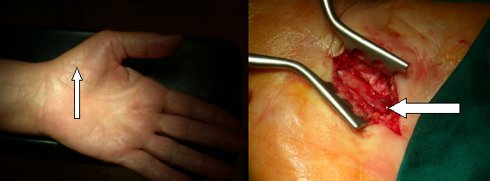The most common one is the "carpal tunnel syndrome", where the median nerve is entrapped under the transverse carpal ligament. The carpal tunnel syndrome typically presents with nocturnal pain to the affected hand (palmar surface, first 3-4 fingers). It is a trivial pathology but may become severe and disabling as patients may no longer sleep or have hand motor deficits. Electromyography, together with careful clinical history, is crucial for a correct diagnosis. There are many other causes of hand pain.
The therapy consists in sectioning the transverse carpal ligament with possible external neurolysis of the median nerve. In our opinion, it is useless to do "surgery of the hand" for carpal tunnel syndrome.
A skilled neurosurgeon performs this operation in about 15-20 minutes, under local anesthesia. If the indication is correct and the surgical technique is correctly applied, results are excellent.

Fig.8.12: On the left, rare case of severe carpal tunnel syndrome with atrophy of the thenar muscle (arrow). This muscle permits thumb opposition, i.e. one of the most important movements of homo sapiens, as all other mammals are unable to perform it. On the right, operative view. The arrow points to the median nerve after cutting of the transverse carpal ligament. The incision is about 2.5 cm.
Page 32
 End
End
 End
End





 Spinal Tumors
Spinal Tumors